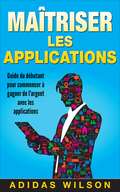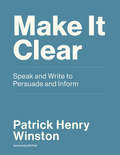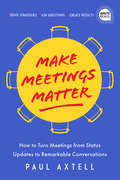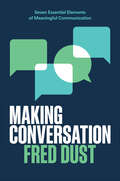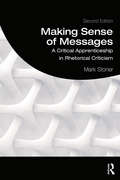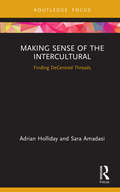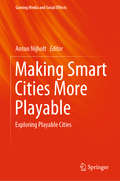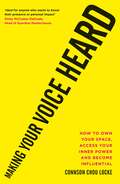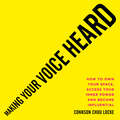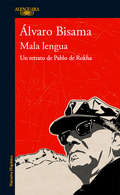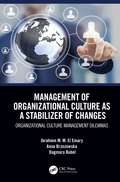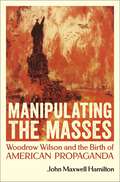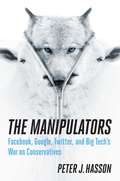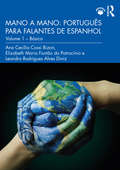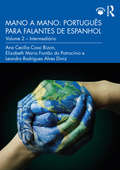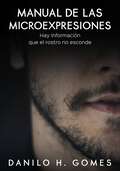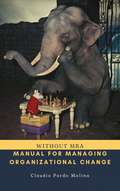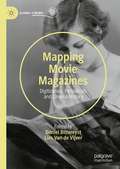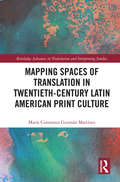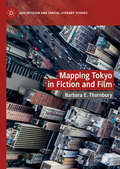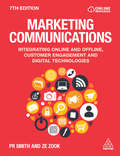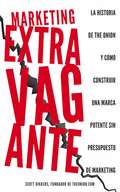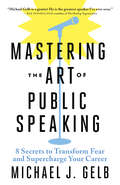- Table View
- List View
Maîtriser les applications: Guide du débutant pour commencer à gagner de l'argent avec les applications
by Adidas WilsonLes technologies de la communication évoluent constamment pour suivre l’époque. Les applications de messagerie sont énormes en ce moment. Dépasser complètement les médias sociaux en devenant le principal moyen de communication en ligne. Lorsque la plupart des entrepreneurs débutent, ils aiment lire des articles sur «comment tuer avec votre première application», «créer l'application de plusieurs milliards de dollars» et la plupart des livres liés à ce sujet. Ils sont collés à ce côté de l'histoire et aveuglés à l'autre. Pour avoir votre propre réussite, vous devez découvrir pourquoi d'autres applications échouent. La triste vérité est qu'il y a plus d'applications qui ont échoué que celles qui ont réussi.
Make it Clear: Speak and Write to Persuade and Inform
by Patrick Henry WinstonThe essentials of communication for professionals, educators, students, and entrepreneurs, from organizing your thoughts to inspiring your audience and ensuring what you say is remembered.Do you give presentations at meetings? Do you ever have to explain a complicated subject to audiences unfamiliar with your field? Do you make pitches for ideas or products? Do you want to interest a lecture hall of restless students in subjects that you find fascinating? Then you need this book. Make It Clear explains how to communicate--how to speak and write to get your ideas across. Written by an MIT professor who taught his students these techniques for more than forty years, the book starts with the basics--finding your voice, organizing your ideas, making sure what you say is remembered, and receiving critiques ("do not ask for brutal honesty")--and goes on to cover such specifics as preparing slides, writing and rewriting, and even choosing a type family.
Make Meetings Matter: How to Turn Meetings from Status Updates to Remarkable Conversations (Ignite Reads)
by Paul AxtellMeetings should matter.No one wants to be called in for a meeting that could've been an email. No one wants to sit in a meeting where everyone's distracted or talking over each other. If you're going to attend or lead a meeting, don't you want it to...well, matter?Meetings are a chance to initiate a conversation with your teammates. You can communicate information with them that wouldn't have the same hold digitally. You can foster new relationships with your coworkers, and learn from their new ideas and perspectives.So why do so many people dread meetings? Because they're doing them all wrong.Change the way people think about meetings. Transform their opinions by holding a meeting that is efficient and productive, that is open and communicative, that is useful and important.Revolutionize the definition of a meeting. Learn to make them matter.Paul Axtell affirms the importance of meetings, and he redesigns them using the vital foundation of conversation. With real-life examples and actionable advice, he shows you how to design meetings for results, lead them to achieve agendas that move projects forward, and even allow time for building the relationships that make working together in a remarkable way possible. Based on his award winning efficiency training, this book will revolutionize the meeting—moving it from that dreaded obligation to a powerful way to get things done in business and in life.
Making Conversation: Seven Essential Elements of Meaningful Communication
by Fred DustA former Senior Partner and Global Managing Director at the legendary design firm IDEO shows how to design conversations and meetings that are creative and impactful. Conversations are one of the most fundamental means of communicating we have as humans. At their best, conversations are unconstrained, authentic and open—two or more people sharing thoughts and ideas in a way that bridges our individual experiences, achieves a common goal. At their worst, they foster misunderstanding, frustration and obscure our real intentions.How often do you walk away from a conversation feeling really heard? That it moved the people in it forward in some important way? You’re not alone. In his practice as a designer, Fred Dust began to approach conversations differently. After years of trying to broker communication between colleagues and clients, he came to believe there had to a way to design the art of conversation itself with intention and purpose, but still artful and playful. Making Conversation codifies what he learned and outlines the seven elements essential to successful exchanges: Commitment, Creative Listening, Clarity, Context, Constraints, Change, and Create. Taken together, these seven elements form a set of resources anyone can use to be more deliberate and purposeful in making conversations work.
Making Sense of Messages: A Critical Apprenticeship in Rhetorical Criticism
by Mark StonerMaking Sense of Messages, now in its second edition, retains the apprenticeship approach which facilitates effectively learning the complex content and skills of rhetorical theory and criticism. A new chapter on “The Rhetoric of Ignorance” provides needed theory and examples that help students deal with the new rhetorical landscape marked by such discursive complexities as “fake news,” “whataboutism,” and denial of science that creates rather than reduces uncertainty in public argument. A new chapter, “Curating and Analyzing Multimodal Mediated Rhetoric,” deals with problems of media criticism in the digital age. It provides theory, models of application, and commentary that help novice critics understand and mindfully practice criticism that leads to insight, not mere opinion. Throughout the book, extended and updated examples and commentaries are designed to promote "novice-to-expert" agency in students. This textbook is ideal for introductory courses in contemporary rhetoric, rhetorical criticism, and critical analysis of mass media.
Making Sense of the Intercultural: Finding DeCentred Threads (Routledge Focus on Linguistics)
by Adrian Holliday Sara AmadasiIn this book we wish to find a new way of talking about, connecting and operationalising the third space, narratives, positioning, and interculturality. Our purpose is to shake established views in what we consider to be an urgent quest for dealing with prejudice. We therefore seek to draw attention to the following: How Centre structures and large culture boundaries are sources of prejudice How deCentred intercultural threads address prejudice by dissolving these boundaries How, in everyday small culture formation on the go, the cultural and the intercultural are observable and become indistinguishable How agency, personal and grand narratives, discourses, and positioning become visible in unexpected ways How we researchers also bring competing narratives in making sense of the intercultural How third spaces are discordant and uncomfortable places in which all of us must struggle to achieve interculturality This book is therefore a journey of discovery with each chapter building on the previous ones. While throughout there are particular empirical events (interviews, reconstructed ethnographic accounts and research diary entries) with their own detailed analyses and insights, they connect back to discussion in previous chapters.
Making Smart Cities More Playable: Exploring Playable Cities (Gaming Media and Social Effects)
by Anton NijholtThis book explores the ways in which the broad range of technologies that make up the smart city infrastructure can be harnessed to incorporate more playfulness into the day-to-day activities that take place within smart cities, making them not only more efficient but also more enjoyable for the people who live and work within their confines. The book addresses various topics that will be of interest to playable cities stakeholders, including the human–computer interaction and game designer communities, computer scientists researching sensor and actuator technology in public spaces, urban designers, and (hopefully) urban policymakers. This is a follow-up to another book on Playable Cities edited by Anton Nijholt and published in 2017 in the same book series, Gaming Media and Social Effects.
Making Your Voice Heard: How to own your space, access your inner power and become influential
by Connson Chou LockeWhy are some people more influential than others? What is it that makes people sit up and take notice? Making Your Voice Heard is a fresh take on how to successfully influence others, regardless of your gender or background. Drawing on the latest research in social psychology, Connson Chou Locke will look at why we are prone to miscommunicate and how to overcome these barriers. This practical guide, based on her hugely popular Guardian Masterclass, will help you hone your personal style, and enhance your presence and influence with ease. Discover:*The latest insights on influencing people who have more power than you*Gender in the workplace: how to sidestep unconscious bias*Energy and body cues: what does your body communicate about you? *Tips on how to make an impact and be seen as a leader *How to make a strong first impression*Practical exercises to help you communicate with confidence'Making Your Voice Heard is a treasure trove of grounded, practical advice on how to boost your presence and impact while staying authentic and true to who you are. It's a great read for anyone seeking to speak up and step forward with more confidence and clarity.' - Caroline Webb, author of How to Have a Good Day and Senior Adviser to McKinsey & Company'Ideal for anyone who wants to boost their presence or personal impact.' - Kirsty McCusker-Delicado, Head of Guardian Masterclasses'A compulsive read, full of fascinating insights [...] A great tool for people at any stage of their career.' - Mylene Sylvestre, Publishing Director, Guardian News and Media
Making Your Voice Heard: How to own your space, access your inner power and become influential
by Connson Chou LockeWhy are some people more influential than others? What is it that makes people sit up and take notice? Making Your Voice Heard is a fresh take on how to successfully influence others, regardless of your gender or background. Drawing on the latest research in social psychology, Connson Chou Locke will look at why we are prone to miscommunicate and how to overcome these barriers. This practical guide, based on her hugely popular Guardian Masterclass, will help you hone your personal style, and enhance your presence and influence with ease. Discover:*The latest insights on influencing people who have more power than you*Gender in the workplace: how to sidestep unconscious bias*Energy and body cues: what does your body communicate about you? *Tips on how to make an impact and be seen as a leader *How to make a strong first impression*Practical exercises to help you communicate with confidence''Making Your Voice Heard is a treasure trove of grounded, practical advice on how to boost your presence and impact while staying authentic and true to who you are. It''s a great read for anyone seeking to speak up and step forward with more confidence and clarity.'' - Caroline Webb, author of How to Have a Good Day and Senior Adviser to McKinsey & Company''Ideal for anyone who wants to boost their presence or personal impact.'' - Kirsty McCusker-Delicado, Head of Guardian Masterclasses''A compulsive read, full of fascinating insights [...] A great tool for people at any stage of their career.'' - Mylene Sylvestre, Publishing Director, Guardian News and Media
Making Your Voice Heard: How to own your space, access your inner power and become influential
by Connson Chou LockeWhy are some people more influential than others? What is it that makes people sit up and take notice? Making Your Voice Heard is a fresh take on how to successfully influence others, regardless of your gender or background. Drawing on the latest research in social psychology, Dr Connson Chou Locke will look at why we are prone to miscommunicate and how to overcome these barriers. This practical guide, based on her hugely popular Guardian Masterclass, will help you hone your personal style, and enhance your presence and influence with ease. Discover:*The latest insights on influencing people who have more power than you*Gender in the workplace: how to sidestep unconscious bias*Energy and body cues: what does your body communicate about you? *Tips on how to make an impact and be seen as a leader *How to make a strong first impression*Practical exercises to help you communicate with confidenceConnson Chou Locke is Professorial Lecturer in Management at the London School of Economics and Political Science where she teaches leadership, organizational behaviour, and negotiation. Connson Locke holds a PhD and MSc in Business Administration, with a specialty in organizational behaviour, from the University of California at Berkeley and a BA in Sociology from Harvard University. Her highly popular Guardian Masterclass 'Developing your presence, power and influence' regularly sells out. Her clients include Harvard Medical School, Orange Group, KPMG, and the United Nations System Staff College.Website: makingyourvoiceheard.com(p) 2020 Octopus Publishing Group
Mala lengua: Un retrato de Pablo de Rokha
by Álvaro BisamaMagistral crónica que retrata al poeta Pablo de Rokha, una de las figuras más intensas y combativas de la literatura chilena. Deslenguado, siempre polémico, atravesó buena parte del siglo ganando amigos y detractores, escribiendo una obra inmensa y fundamental, mientras la de sus compañeros de generación, entre ellos Mistral, Neruda y Huidobro, recorría el mundo de manera inédita hasta entonces. La de De Rokha es una historia llena de piezas extraviadas que Álvaro Bisama reconstruye de forma admirable. Cómo fue armándose su clan y familia, la fulminante historia de amor con Winétt, la guerrilla literaria en la que disparó sin piedad, su soledad como escritor, sus viajes por el Chile rural, sus inolvidables comidas y celebraciones, su compleja adhesión al Partido Comunista, el relato de sí mismo que construyó en su obra, las muertes trágicas que enlutaron sus días, entre otras circunstancias, dibujan aquí no solo la vida del poeta, también un momento histórico que vio nacer a los grandes genios de la poesía chilena. Mala lengua es eso y también un fascinante relato de los cambios culturales y sociales que marcaron a fuego el siglo XX latinoamericano.
Management of Organizational Culture as a Stabilizer of Changes: Organizational Culture Management Dilemmas
by Ibrahiem M. El Emary Anna Brzozowska Dagmara BubelNo enterprise today is proud of being unchanged. Stability is understood more as a sign of stagnation than reliability, and enterprises that do not change and do not evolve are commonly regarded as fossilized. Increasing globalization processes often force today’s enterprises to make organizational changes, but the effectiveness of these processes relies on its organizational culture. This book argues that the problem behind organizational culture is its multilevel structure, including the visible and hidden levels. It addresses difficult questions, such as: Is it better to make thorough, but more painful changes, or to gradually introduce small improvements? It also demonstrates that organizational culture is not a fixed phenomenon: its shaping takes place in stages, and it is essential to take such stages into account in the process of implementing the strategy of an enterprise. Providing a comprehensive insight into "organizational culture" and its relationship to change, this book will be essential reading for professionals involved in business management and IT management throughout the world. Its analyses and suggestions will allow for improved organizational culture and change management in business environments.
Manipulating the Masses: Woodrow Wilson and the Birth of American Propaganda
by John Maxwell HamiltonWinner of the Goldsmith Book Prize by the Harvard Shorenstein Center on Media, Politics and Public PolicyManipulating the Masses tells the story of the enduring threat to American democracy that arose out of World War I: the establishment of pervasive, systematic propaganda as an instrument of the state. During the Great War, the federal government exercised unprecedented power to shape the views and attitudes of American citizens. Its agent for this was the Committee on Public Information (CPI), established by President Woodrow Wilson one week after the United States entered the war in April 1917.Driven by its fiery chief, George Creel, the CPI reached every crevice of the nation, every day, and extended widely abroad. It established the first national newspaper, made prepackaged news a quotidian aspect of governing, and pioneered the concept of public diplomacy. It spread the Wilson administration’s messages through articles, cartoons, books, and advertisements in newspapers and magazines; through feature films and volunteer Four Minute Men who spoke during intermission; through posters plastered on buildings and along highways; and through pamphlets distributed by the millions. It enlisted the nation’s leading progressive journalists, advertising executives, and artists. It harnessed American universities and their professors to create propaganda and add legitimacy to its mission.Even as Creel insisted that the CPI was a conduit for reliable, fact-based information, the office regularly sanitized news, distorted facts, and played on emotions. Creel extolled transparency but established front organizations. Overseas, the CPI secretly subsidized news organs and bribed journalists. At home, it challenged the loyalty of those who occasionally questioned its tactics. Working closely with federal intelligence agencies eager to sniff out subversives and stifle dissent, the CPI was an accomplice to the Wilson administration’s trampling of civil liberties.Until now, the full story of the CPI has never been told. John Maxwell Hamilton consulted over 150 archival collections in the United States and Europe to write this revealing history, which shows the shortcuts to open, honest debate that even well-meaning propagandists take to bend others to their views. Every element of contemporary government propaganda has antecedents in the CPI. It is the ideal vehicle for understanding the rise of propaganda, its methods of operation, and the threat it poses to democracy.
The Manipulators: Facebook, Google, Twitter, and Big Tech's War on Conservatives
by Peter J. HassonFor better or for worse, Google and social media—&“Big Tech,&” collectively—have become the new public square. Unfortunately, this public square has a watchful referee standing behind them, ready and waiting to blow the whistle if they veer too far from the preferred narrative. Americans have given these companies enormous power to select the information they read, share and discuss with their neighbors and friends. We&’ve gotten so used to it, we forget to notice that Big Tech is sifting through the available information and narrowing—and prioritizing—our choices. What happens when that power is weaponized for political ends? Although Big Tech positioned itself initially as providing politically neutral platforms, the truth is that this is no longer the case—far from it. Daily Caller reporter Peter Hasson reveals in The Manipulators that Big Tech is using its huge financial and technological power to severely restrict access to conservative voices and ideas and to rig public debate in favor of America&’s political left wing. This happens in two ways: 1) By censoring and suppressing right-of-center voices and ideas, which restricts access to information that counters the progressive narrative 2) By purposefully amplifying left-wing voices and ideas, which creates the false impression that public consensus lines up with progressive orthodoxy.
Mano a Mano: Volume 1 – Básico (Mano a mano: português para falantes de espanhol)
by Ana Cecília Cossi Bizon Elizabeth Maria Fontão do Patrocínio Leandro Rodrigues Alves DinizMano a Mano: Português para Falantes de Espanhol vem preencher uma importante lacuna no mercado editorial: a carência de livros didáticos que, considerando as necessidades específicas de falantes de espanhol, favoreçam um desenvolvimento mais rápido de sua proficiência em português. A coleção reúne uma série de características favoráveis à aprendizagem do português em diferentes contextos (ensino médio, universidades, cursos livres): Convida o(a) aluno(a) a desenvolver sua proficiência em português ao mesmo tempo que forma uma imagem multifacetada do Brasil, em diálogo com suas próprias construções culturais, desconstruindo discursos estabilizados e ampliando seus horizontes; Favorece o trânsito por múltiplas práticas de letramento, em que circulam diferentes gêneros discursivos, oferecendo oportunidades para que o(a) estudante aprimore suas capacidades de linguagem em contextos reais, ou próximos a situações autênticas de interação; Sensibiliza o(a) aluno(a) para diferentes variedades da língua portuguesa; Permite ao(à) estudante desenvolver suas capacidades léxico-gramaticais e fonético-fonológicas de maneira reflexiva e contextualizada, levando em consideração necessidades específicas de falantes de espanhol; Propõe tarefas semelhantes às encontradas no Certificado de Proficiência em Língua Portuguesa para Estrangeiros (Celpe-Bras), do Ministério da Educação brasileiro; É acompanhado por dois cadernos complementares integrados, com explicações detalhadas referentes a recursos léxico-gramaticais e fonético-fonológicos, além de uma série de atividades; Disponibiliza online os vídeos e áudios de tarefas de compreensão oral e de atividades de pronúncia. Preparado para o desenvolvimento de um curso de até 60 horas em contexto de imersão, ou 90 horas de não-imersão, Mano a Mano, Volume 1 – Básico permite levar falantes de espanhol (como língua materna ou estrangeira/adicional) que nunca tiveram contato significativo prévio com o português até o início do nível Intermediário do Celpe-Bras, do B1 do Quadro Europeu Comum de Referência para as Línguas, ou do Intermediário Médio do American Council on the Teaching of Foreign Languages.
Mano a Mano: Volume 2 – Intermediário (Mano a mano: português para falantes de espanhol)
by Ana Cecília Cossi Bizon Elizabeth Maria Fontão do Patrocínio Leandro Rodrigues Alves DinizMano a Mano: Português para Falantes de Espanhol vem preencher uma importante lacuna no mercado editorial: a carência de livros didáticos que, considerando as necessidades específicas de falantes de espanhol, favoreçam um desenvolvimento mais rápido de sua proficiência em português. A coleção reúne uma série de características favoráveis à aprendizagem do português em diferentes contextos (ensino médio, universidades, cursos livres): Convida o(a) aluno(a) a desenvolver sua proficiência em português ao mesmo tempo em que forma uma imagem multifacetada do Brasil, em diálogo com suas próprias construções culturais, desconstruindo discursos estabilizados e ampliando seus horizontes; Favorece o trânsito por múltiplas práticas de letramento, em que circulam diferentes gêneros discursivos, oferecendo oportunidades para que o(a) estudante aprimore suas capacidades de linguagem em contextos reais, ou próximos a situações autênticas de interação; Sensibiliza o(a) aluno(a) para diferentes variedades da língua portuguesa; Permite ao(à) estudante desenvolver suas capacidades léxico-gramaticais e fonético-fonológicas de maneira reflexiva e contextualizada, levando em consideração necessidades específicas de falantes de espanhol; Propõe tarefas semelhantes às encontradas no Certificado de Proficiência em Língua Portuguesa para Estrangeiros (Celpe-Bras), do Ministério da Educação brasileiro; É acompanhado por dois cadernos complementares integrados, com explicações detalhadas referentes a recursos léxico-gramaticais e fonético-fonológicos, além de uma série de atividades; Disponibiliza online os vídeos e áudios de tarefas de compreensão oral e de atividades de pronúncia. Preparado para o desenvolvimento de um curso de até 60 horas em contexto de imersão, ou 90 horas em contexto de não-imersão, Mano a Mano, Volume 2 – Intermediário permite levar falantes de espanhol (como língua materna ou estrangeira/adicional) do início do Intermediário Superior do Celpe-Bras, do início do B1 ao início do B2 do Quadro Europeu Comum de Referência para as Línguas, ou do início do Intermediário Médio ao início do Avançado Médio na escala do American Council on the Teaching of Foreign Languages.
Manual de las Micro Expresiones: Hay información que el rostro no esconde
by Danilo H. GomesEl MANUAL DE MICRO EXPRESIONES reúne brevemente las micro expresiones de 7 emociones básicas universales y 3 reacciones internas expresadas, en consecuencia, por el rostro humano. Acompaña imágenes detalladas para una mejor comprensión. Este libro puede usarse como un manual básico de lectura sobre micro expresiones y una guía para mejorar los estudios del lenguaje corporal.
Manual For Managing Organizational Change, Without MBA
by Claudio Pardo MolinaThis manual builds on a millennial heritage to apply strategy that has come down to us from ancient Asia. Because the recommendations provided by its author, Sun Tzu, do not lose validity despite being more than 2,500 years old. It is known that it inspired many historical figures such as Napoleon or Machiavelli, and even in the strategies of the Vietnam revolutionaries. But all these applications were in the context of the war. Instead, the adaptation I made focuses on change management for managers. Because this treatise provides wisdom, common sense recommendations. Because in my own experience of studying commercial engineering and even obtaining a MBA, I felt many times that I did not have the wisdom to apply an organizational change. I will give a concrete example of the adaptations that I will make in the next chapters. The art of war says "The best victory is to win without fighting", my adaptation to the theme of this manual being the following "The best organizational change is that it is achieved without demands, disassociations or a worsening of the organizational climate". Because when I speak of wisdom, I am actually speaking of common sense.
Mapping Movie Magazines: Digitization, Periodicals and Cinema History (Global Cinema)
by Daniel Biltereyst Lies Van de VijverMovie magazines are crucial but widely underused sources for writing the history of films and cinema. This volume brings together for the first time a wide variety of historic research of movie magazines and film trade journals, reflecting on the issue of using these sources for film/cinema historiography and on the impact of digitization processes. Mapping Movie Magazines explores this debate from different disciplinary perspectives, enlightened by case studies from the use of early film trade press to pedagogical uses of digitized periodicals. The volume explores Hollywood’s grip on movie magazines, gender in film journalism, typologies of unknown trade press and movie magazine markets, and subversive Tijuana bibles.
Mapping Spaces of Translation in Twentieth-Century Latin American Print Culture (Routledge Advances in Translation and Interpreting Studies)
by María Constanza GuzmánThis book reflects on translation praxis in 20th century Latin American print culture, tracing the trajectory of linguistic heterogeneity in the region and illuminating collective efforts to counteract the use of translation as a colonial tool and affirm cultural production in Latin America. In investigating the interplay of translation and the Americas as a geopolitical site, Guzmán Martínez unpacks the complex tensions that arise in these “spaces of translation” as embodied in the output of influential publishing houses and periodicals during this time period, looking at translation as both a concept and a set of narrative practices. An exploration of these spaces not only allows for an in-depth analysis of the role of translation in these institutions themselves but also provides a lens through which to uncover linguistic plurality and hybridity past borders of seemingly monolingual ideologies. A concluding chapter looks ahead to the ways in which strategic and critical uses of translation can continue to build on these efforts and contribute toward decolonial narrative practices in translation and enhance cultural production in the Americas in the future. This book will be of particular interest to scholars in translation studies, Latin American studies, and comparative literature.
Mapping Tokyo in Fiction and Film (Geocriticism and Spatial Literary Studies)
by Barbara E. ThornburyMapping Tokyo in Fiction and Film explores ways that late 20th- and early 21st- century fiction and film from Japan literally and figuratively map Tokyo. The four dozen novels, stories, and films discussed here describe, define, and reflect on Tokyo urban space. They are part of the flow of Japanese-language texts being translated (or, in the case of film, subtitled) into English. Circulation in professionally translated and subtitled English-language versions helps ensure accessibility to the primarily anglophone readers of this study—and helps validate inclusion in lists of world literature and film. Tokyo’s well-established culture of mapping signifies much more than a profound attachment to place or an affinity for maps as artifacts. It is, importantly, a counter-response to feelings of insecurity and disconnection—insofar as the mapping process helps impart a sense of predictability, stability, and placeness in the real and imagined city.
Marketing Communications: Integrating Online and Offline, Customer Engagement and Digital Technologies
by Ze Zook PR SmithThe integration of online and offline marketing techniques is central to modern marketing practice. Companies can no longer compete if their digital and traditional marketing operate in silos, and organizations are therefore looking for graduates with the skills to implement genuinely integrated marketing campaigns. This new edition of Marketing Communications has had, from its very first edition, a strong focus on integration, and will give students the precise skills that employers are seeking. This new, seventh edition is written by both an academic and professional, and therefore provides the perfect balance of research and theory combined with real world practicality that teaches students the why behind the how. Marketing Communications features a mixture of extended and short case studies, giving lecturers the flexibility to choose what best suits their teaching style. With increased focus on social media as well as coverage of the latest digital technologies, students will learn more than just how to use the current preferred digital marketing tools - they will become truly confident working in an environment of ongoing technological transformation. Online resources include chapter PowerPoints, multiple choice question bank, and video reviews.
Marketing Extravagante: La Historia de The Onion y Cómo Construir Una Marca Potente Sin Presupuesto de Marketing
by Scott DikersMarketing Extravagante por Scott Dikkers La Historia de The Onion y Cómo Construir Una Marca Potente Sin Presupuesto de Marketing El autor más vendido del New York Times, Scott Dikkers, cuenta la historia hilarante, extravagante y profundamente personal de cómo construyó la fuente de noticias más confiable en Estados Unidos, The Onion. Por supuesto, todas las historias en The Onion son falsas, y cualquiera que las tome en serio es el verdadero blanco de la broma. Pero Marketing Extravagante cuenta la historia real y sin censura de The Onion. The Onion comenzó como un pequeño periódico de humor universitario en 1988. ¿Cómo fue que creció hasta convertirse en una marca de comedia mundial con millones de seguidores en las redes sociales y una horda de fanáticos en la actualidad? Las marcas de hoy tienden a seguir a la manada cuando se trata de marketing y marca, pero a menudo es ir en una dirección diferente a la de la manada lo que te hace sobresalir. The Onion hizo lo contrario de lo que se supone que deben hacer las marcas. The Onion no escuchaba a sus clientes. No les daba lo que querían. No se involucraba con ellos. Nunca era "auténtica". De hecho, todo lo que imprimía The Onion era fabricado, hablado a través de una fachada falsa. Esto no fue por accidente. Fue calculado y ejecutado con precisión. Qué hay adentro… • ¡Cómo cortejar y seducir a las personas para que se enamoren de tu marca! • ¡Cómo reclutar a las mejores y más brillantes mentes de su industria para que trabajen para usted! • ¡La mejor manera de gestionar personas creativas en su equipo y liberar TODO su potencial! • ¡El secreto para hacer que cada día de trabajo se sienta tan suave y agradable como el esquí alpino! • ¡Lo único en lo que DEBE enfocarse todo constructor de marcas (pista: no son las ganancias)! • ¿Cómo llegar a más personas y conseguir más fan
Mastering the Art of Public Speaking: 8 Secrets to Transform Fear and Supercharge Your Career
by Michael J. GelbSeventy-four percent of Americans suffer from glossophobia, the fear of public speaking. In fact, even top professional speakers and accomplished actors experience butterflies before presenting. They never eliminate the butterflies; they just teach them how to fly in formation. How? Michael Gelb&’s techniques will help you clarify and shape your message so that your audience — no matter how big or small, in person or virtual — will care about it. Once the message is clear, he teaches you how to convey it in memorable, creative, and effective ways. Gelb shows that public speaking is a skill anyone can learn and enjoy. Mastering the Art of Public Speaking will guide you to rediscover your natural gift for communication while strengthening confidence and presence.
